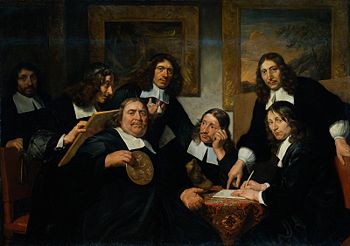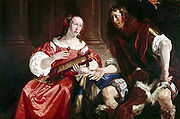
Jan de Bray
Encyclopedia

Dutch Golden Age
The Golden Age was a period in Dutch history, roughly spanning the 17th century, in which Dutch trade, science, military and art were among the most acclaimed in the world. The first half is characterised by the Eighty Years' War till 1648...
painter.
Biography
Jan de Bray was born in HaarlemHaarlem
Haarlem is a municipality and a city in the Netherlands. It is the capital of the province of North Holland, the northern half of Holland, which at one time was the most powerful of the seven provinces of the Dutch Republic...
. According to Houbraken he was the most famous pupil of his father, the architect and poet Salomon de Bray
Salomon de Bray
Salomon de Bray was a Dutch Golden Age architect and painter.-Biography:De Bray was born inAmsterdam, but established himself in Haarlem before 1617, where he is registered as being a member of the schutterij that year in the St. Adrian's cloveniers...
. Houbraken called Jan the "pearl in Haarlem's crown". Houbraken saw a painting by de Bray of David
David
David was the second king of the united Kingdom of Israel according to the Hebrew Bible and, according to the Gospels of Matthew and Luke, an ancestor of Jesus Christ through both Saint Joseph and Mary...
and the Return of the Ark of the Covenant
Ark of the Covenant
The Ark of the Covenant , also known as the Ark of the Testimony, is a chest described in Book of Exodus as solely containing the Tablets of Stone on which the Ten Commandments were inscribed...
in the collection of Arnold van Halen in Amsterdam, dated 1697, that he admired for its realistic flesh tones in the forms of David playing the harp and the Levite
Levite
In Jewish tradition, a Levite is a member of the Hebrew tribe of Levi. When Joshua led the Israelites into the land of Canaan, the Levites were the only Israelite tribe that received cities but were not allowed to be landowners "because the Lord the God of Israel himself is their inheritance"...
s behind him. Houbraken also mentioned some black and red chalk drawings by him that he saw at the Amsterdam home of Isaak del Court.
He spent most of his career working in Haarlem
Haarlem
Haarlem is a municipality and a city in the Netherlands. It is the capital of the province of North Holland, the northern half of Holland, which at one time was the most powerful of the seven provinces of the Dutch Republic...
, where he was for many years dean of the Haarlem Guild of St. Luke
Haarlem Guild of St. Luke
The Haarlem Guild of Saint Luke was first a Christian, and later a city Guild for a large number of trades falling under the patron saints Luke the Evangelist and Saint Eligius.-History:...
. His brother Dirck de Bray
Dirck de Bray
Dirck de Bray was a Dutch Golden Age painter.-Biography:According to Houbraken he was a multi-talented son and pupil of the painter and architect Salomon de Bray. He was known as a flower painter, but he could also sculpt...
was a flower painter who later became a monk in the monastery at Gaesdonck near Goch
Goch
Goch is a town in the district of Kleve, in North Rhine-Westphalia, Germany. It is situated close to the border with the Netherlands, approx. 12 km south of Kleve, and 27 km southeast of Nijmegen.-Cultural ties:...
. His brother Joseph was also a painter, and his sister Cornelia married Jan Lievens
Jan Lievens
Jan Lievens was a Dutch painter, usually associated with Rembrandt, working in a similar style.-Biography:According to Arnold Houbraken, Jan was the son of Lieven Hendriksze, a tapestry worker , and was trained by Joris Verschoten. He was sent to Pieter Lastman in Amsterdam at about the age of 10...
. His mother was Anna Westerbaen, the sister of the painter Jan Westerbaen and the poet Jacob Westerbaen
Jacob Westerbaen
Ridder Jacob Westerbaen , heer of Brantwyck-en-Ghybelant, was a Dutch poet.-Life:Westerbaen was born in The Hague, the son of a rope maker, and was initially schooled in the Staten-College, then as secretary and preacher of the Remonstrants of the Synod of Dort...
.
de Bray lost his father and two siblings to the plague. His wives - Maria van Hees (married 21 October 1688 ), Margaretha de Meyer (married 1672 ), and Victoria Stalpert van der Wielen (married 30 January 1678 ) - each died; Victoria shortly after giving birth to their son, Johan Lucas. In 1689 he was declared bankrupt as a Haarlem citizen and moved to Amsterdam, where he died. He was buried in Haarlem.
Works
Jan de Bray was influenced by his father, Bartholomeus van der HelstBartholomeus van der Helst
Bartholomeus van der Helst was a Dutch portrait painter.-Biography:Born in Haarlem, the son of a Haarlem innkeeper, Van der Helst moved to Amsterdam some time before 1636, for he was married there in that year...
, and Frans Hals
Frans Hals
Frans Hals was a Dutch Golden Age painter. He is notable for his loose painterly brushwork, and helped introduce this lively style of painting into Dutch art. Hals was also instrumental in the evolution of 17th century group portraiture.-Biography:Hals was born in 1580 or 1581, in Antwerp...
. De Bray's works are mainly portraits, often of groups. He specialised in posing specific figures as historical figures, thus achieving paintings that encompassed the genre
Genre
Genre , Greek: genos, γένος) is the term for any category of literature or other forms of art or culture, e.g. music, and in general, any type of discourse, whether written or spoken, audial or visual, based on some set of stylistic criteria. Genres are formed by conventions that change over time...
s of portrait and history painting. The French term for these, "portrait historié" (literally "historicised portrait") is also used in English, sometimes without the accent. Among his finest works are two versions of the Banquet of Cleopatra, using his own family, including himself, as models (Royal Collection
Royal Collection
The Royal Collection is the art collection of the British Royal Family. It is property of the monarch as sovereign, but is held in trust for her successors and the nation. It contains over 7,000 paintings, 40,000 watercolours and drawings, and about 150,000 old master prints, as well as historical...
, 1652, and Currier Museum of Art
Currier Museum of Art
The Currier Museum of Art is an art museum in Manchester, New Hampshire, USA, featuring European and American paintings, decorative arts, photographs and sculpture. The permanent collection includes works by Picasso, Matisse, Monet, O'Keeffe, Calder, Scheier and Goldsmith, John Singer Sargent,...
, New Hampshire
New Hampshire
New Hampshire is a state in the New England region of the northeastern United States of America. The state was named after the southern English county of Hampshire. It is bordered by Massachusetts to the south, Vermont to the west, Maine and the Atlantic Ocean to the east, and the Canadian...
, 1669). The second version has great pathos, as most of those depicted had died in the plague of 1663-4.
As a key figure in Dutch Classicalism of the seventeenth century, De Bray, like his contemporaries, drew inspiration from the same ancient writers and sources as the Italian artists of the fifteenth century. Working in the classical tradition, these artists emphasised harmony, proportion and balance in their compositions in order to present an idealised beauty.

External links
- Jan de Bray on ArtnetArtnetartnet is an online service provider for the international art market with headquarters in New York, Berlin and Paris. Additionally, artnet has regional offices in China, the UK and Russia.- Business model :...
- Works and literature on PubHist
- Murray, P. & L. (1996). Dictionary of art and artists (p. 65). London: Penguin Books. ISBN 0-14-051300-0. (For details see: Sources)
- Jan De Bray and the Classical Tradition at the National Gallery of Art, Washington - 16pp pdf exhibition brochure
- Entry for Jan de Bray in the RKD, the Netherlands Institute for Art History

